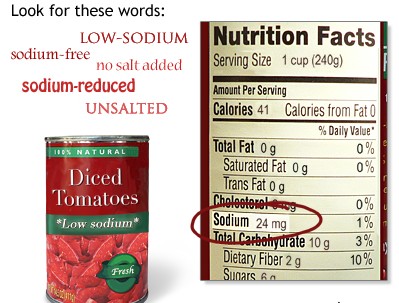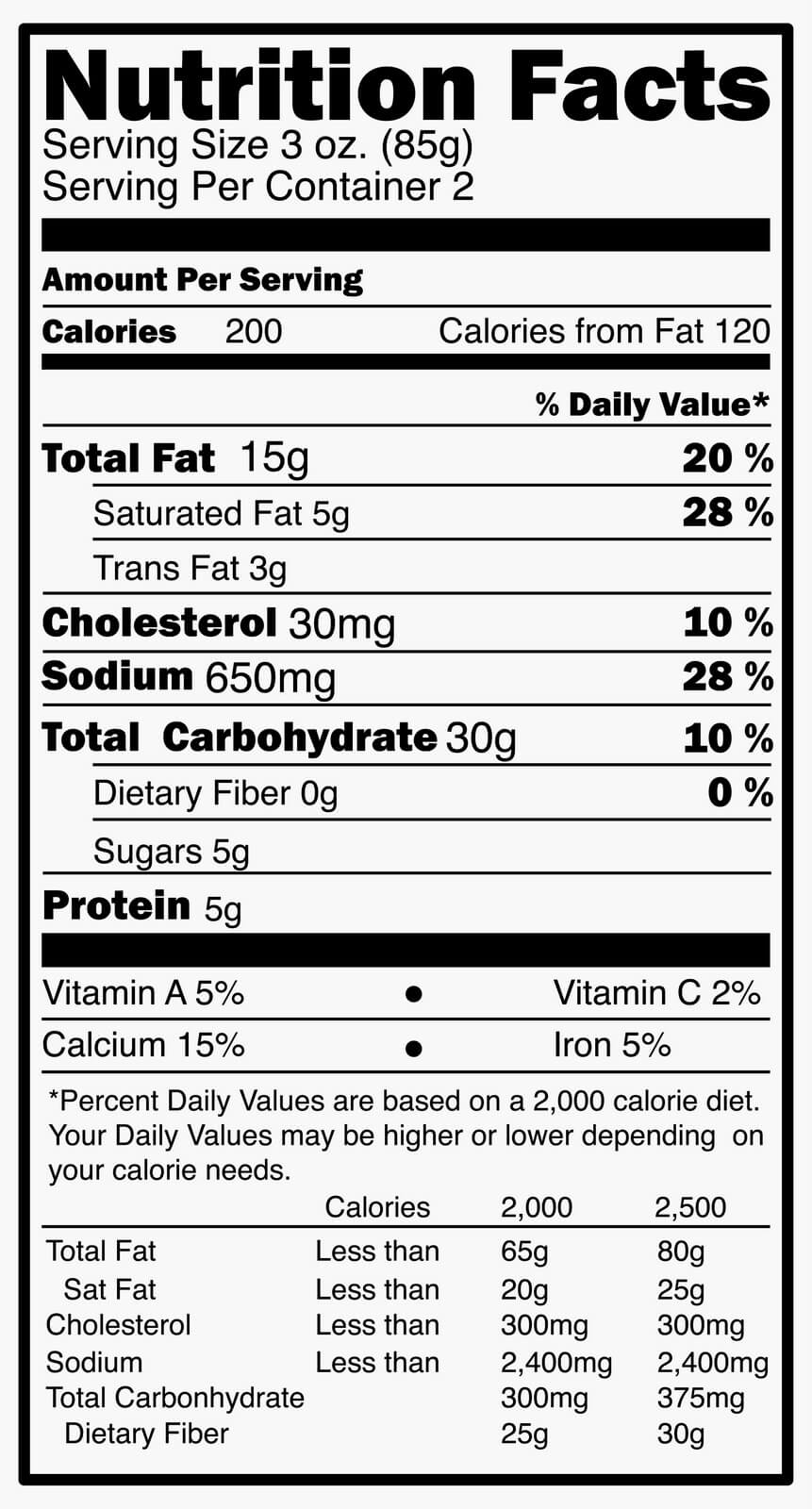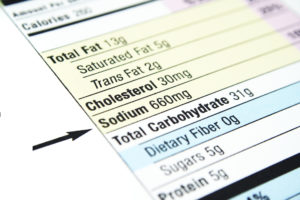41 reading sodium on food labels
How to Read a Food Label to Limit Sodium: Care … The label lists the ingredients in a food in descending order (from the most to the least). If salt or sodium is high on the list, there may be a lot of sodium in the food. Know that sodium has different names. Sodium is also called monosodium glutamate (MSG), sodium citrate, sodium alginate, and sodium phosphate. Read Nutrition Facts labels. On most foods, there is a … How do you read a food label for salt / sodium? - Irish Kidney Diet 03/03/2016 · If the salt content is not available on a label you can calculate it from the sodium content using the following: Sodium x 2.5 = salt content or Salt ÷ 2.5 = sodium content If you have kidney disease a good goal for sodium intake is 2300 mg of sodium or 6g salt per day. Check with your Doctor or Kidney (Renal) Dietitian to confirm what your maximum daily salt …
Food Labels: Read It Before You Eat It! - AAAAI Reading a food label for allergens is different from what you might be used to. It is more than just looking at the carbs, protein, salt and calorie count. ... Some common food allergens are listed using technical names instead of their everyday ones. For example, sodium caseinate can be used to indicate that a product contains a milk protein ...
Reading sodium on food labels
How To Read Nutrition Labels 3. Check the % Daily Value. The % Daily Value (DV) tells you how much a nutrient in a serving of food contributes to a daily diet. 2,000 calories a day is used for general nutrition advice. Low is 5% or less. Aim for low in saturated fat, trans fat, cholesterol, sodium, and added sugars. High is 20% or more. Aim high in vitamins, minerals and ... Sodium and Food Labels | Sutter Health It's important to note that all nutritional labels list amounts of nutrients per serving. This item, for example, lists 16 servings in the entire container. The sodium level is 120 mg for one serving. That means if you drink the entire container, you'll get 1,920 mg sodium! That could be a critical error if you're not careful. Reading Food Nutrition Labels 101 and How to Decode Them Limit the high sodium foods you eat, aiming for a daily intake of 2400 milligrams or less. Sodium-free - less than 5 milligrams per serving Low sodium - 140 milligrams or less per serving Reduced sodium - at least 25% less sodium than the original version Carbohydrates and Protein Content Carbohydrates have their own special listings as well.
Reading sodium on food labels. How to Understand and Use the Nutrition Facts Label | FDA Nutrients to get less of: Saturated Fat, Sodium, and Added Sugars. Saturated fat, sodium, and added sugars are nutrients listed on the label that may be associated with adverse health effects - and... How to read a food label - TODAY.com Read the back label. Consumers need to read the whole nutrition label carefully to know if they're selecting the most nutritious foods. Read the specific nutrient content per serving on the back ... Reading and Understanding Food Labels and Nutrition Info - Beaumont Health A one-percent reduction of saturated fat in your diet reduces your heart disease risk by three percent. Keep saturated fat to less then 15 grams per day. It is not required to list unsaturated fats (polyunsaturated and monounsaturated) on food labels. In general, unsaturated fats lower cholesterol. The healthiest unsaturated fat is canola oil. Reading Food Labels to Look for Sodium read food labels is a good first step in a sensible eating plan. If the Label Says: One Serving of the Product Has: Sodium-free, salt-free or no sodium Less than 5 mg of sodium and no sodium chloride in ingredients Very low sodium 35 mg or less of sodium No added salt or unsalted No salt added to the product during processing (this is not a sodium-free product)
Sodium & Your Heart Health: How To Read Nutrition Facts On Food Labels Food can be considered low-sodium if the total sodium content is 140mg or less and is based on serving size. Overindulging on the portions with a low-sodium food can potentially be just as detrimental as eating a food that's high in salt. Additionally, people shopping for low-sodium foods should opt for packaging that features a 5% DV or lower. Sodium on the Nutrition Facts Label | FDA Most Americans eat too much sodium and diets higher in sodium are associated with an increased risk of developing high blood pressure. The Nutrition Facts label is a handy tool you can use every... How to Read a Food Label to Limit Sodium: Care Instructions The label lists the ingredients in a food in descending order (from the most to the least). If salt or sodium is high on the list, there may be a lot of sodium in the food. Know that sodium has different names. Sodium is also called monosodium glutamate (MSG), sodium citrate, sodium alginate, and sodium phosphate. Read Nutrition Facts tables Sodium: How to Read Food Labels - Intermountain Healthcare The label might say it is “ low sodium,” but how do you know how much that really is? Here’s a cheat sheet: Sodium free — Less than 5 milligrams of sodium per serving. Very low sodium — 35 milligrams or less of sodium per serving. Low sodium — 149 milligrams or less of sodium per serving. Reduced sodium — 25% less sodium than the original version
How to Read Labels for a Low Sodium Diet - Salt Sanity Sodium nitrate is used to cure meats so you'll likely find it on labels of foods like lunch meat, bacon, and hot dogs. Research indicates sodium nitrate can damage arteries, causing them to harden and narrow, a potentially dangerous situation for patients with heart disease. There are some high sodium ingredients you will recognize. Sodium: How to Read Food Labels - Intermountain Healthcare NUTRITION INFORMATION FROM YOUR DIETITIAN ... Reading food labels can help you monitor how much sodium you are getting in your diet. Here are some of. What Should I Look for When I Read Nutrition Labels? Here's your quick list to determine if the label you're reading passes the PLANTSTRONG sniff test. 1) Sodium: Your recommended total daily intake should be around 1500-2000mg daily so when reading a label, you want the number of calories per serving to be equal to or lesser than the number of milligrams of sodium per serving. How to Read Sodium Percentages on Food Packages Food labels typically feature a column titled “Percent Daily Value.” According to the American Heart Association, this column identifies the percent of sodium in a single serving in relation to the daily recommended amount. If you’re looking to …
Label reading 101 - Healthy Food Guide Label reading cheat sheet For any packaged food product you choose, the health guidelines to aim for are: Less than 10g fat per 100g Less than 15g sugar per 100g Less than 120mg sodium per 100g What about the Health Star Rating? This Australian government health initiative ranks products on a scale from half a star to five stars.
5 tips for decoding food labels - Harvard Health Here are 5 ways to make food labels work for you: Size matters. Serving size is always the first item on the label. All other information is based on that serving size. The servings per container tell you know how many portions are in the whole box, package, or can. Beware: many packages contain more than one serving.
Understanding Food Nutrition Labels | American Heart Association If you want to consume less of a nutrient (such as saturated fat or sodium), choose foods with a lower % DV (5 percent or less). If you want to consume more of a nutrient (such as fiber), choose foods with a higher % DV (20 percent or more). Here are more tips for getting as much health information as possible from the Nutrition Facts label:
PDF How to Read the Food Label - Risk Services food is a good choice for you. Know your fats. Look for foods . low in saturated fats, trans fats, and cholesterol to help reduce the risk of heart disease (5% DV or less). There's no DV for trans fat because it's best to limit or avoid it. Keep sodium in check. Processed foods are often high . in sodium. Look for low- sodium foods with ...
How to Read Salt Labels | Cooking Light When food companies make sodium claims, they have to follow labeling rules. For the consumer, the tricky part is that there are four claims. Two apply when a company is comparing their food to a loosely defined fully salted version. One refers to a specific sodium level, another to whether salt has been added.
How to Read a Food Label to Limit Sodium: Care Instructions This will tell you how much sodium is in one serving of food. Look at both the serving size and the sodium amount. The serving size is located at the top of the ...
PDF Read the Nutrition Facts Label for Sodium! - NHLBI, NIH Sodium 125mg 5% Total Carbohydrate 9g 3% Dietary Fiber 3g 12% Sugars 4g Protein 2g Vitamin A 35% • Vitamin C 6% Calcium 2% • Iron 2% Read the Nutrition Facts Label for Sodium! Nutrition Facts labels tell you what you need to know about choosing foods that are lower in sodium. Here is a Nutrition Facts label for frozen peas and carrots ...
Food Labels | CDC In general, eat more foods that are higher in vitamins, minerals (such as calcium and iron), and fiber. Eat fewer foods that are higher in added sugars, saturated fat, and sodium (salt), and avoid trans fat. Keep in mind that the % Daily Value of each nutrient, such as total fat of 10% in the example below, is based on eating 2,000 calories a day.
Controlling Sodium and Reading Labels - Veterans Affairs • Very low sodium: less than 35 milligrams of sodium per serving. • Low sodium: less than 140 milligrams of sodium per serving. 3) Read ingredient lists Labels list the ingredients in order with those that weigh the most appearing first and those that weigh the least appearing last. Choose foods where sodium is listed near the end of the list. Be on the lookout for ingredients that …
Sodium: Look at the Label - Food and Drug Administration serving of food is high or low in sodium and to compare food products. As a general guide: 5% DV or less per serving of sodium is considered low, and 20% DV or more per
Reading Labels - World Action on Salt & Health Some food labels may only state the sodium content. To convert sodium to salt, you need to multiply the amount by 2.5. For example, 1g of sodium per 100g = 2.5 grams of salt per 100g You then need to know the weight of the serving portion in grams e.g. 30g Then divide the concentration of salt per 100g by 100 and multiply by the serving size.
How To Read Food and Beverage Labels | National Institute on Aging Most older adults exceed the recommended limits for saturated fats, sodium, and added sugars. Compare and choose foods to get less than 100% DV of these each day, making sure to adjust for how many calories are in your diet. Additionally, many older adults do not get the recommended amounts of dietary fiber, vitamin D, calcium, and potassium.
What Sodium Labels Mean: A Guide to Decoding … On the back of a product, you'll find the nutrition label which will list the percentage daily value (or %DV) of sodium found in one serving. Be aware that the %DV is based on the upper recommended limit of daily sodium, or 2,400mg. Remember to Check the Serving Size
Reading Food Nutrition Labels 101 and How to Decode Them Limit the high sodium foods you eat, aiming for a daily intake of 2400 milligrams or less. Sodium-free - less than 5 milligrams per serving Low sodium - 140 milligrams or less per serving Reduced sodium - at least 25% less sodium than the original version Carbohydrates and Protein Content Carbohydrates have their own special listings as well.
Sodium and Food Labels | Sutter Health It's important to note that all nutritional labels list amounts of nutrients per serving. This item, for example, lists 16 servings in the entire container. The sodium level is 120 mg for one serving. That means if you drink the entire container, you'll get 1,920 mg sodium! That could be a critical error if you're not careful.
How To Read Nutrition Labels 3. Check the % Daily Value. The % Daily Value (DV) tells you how much a nutrient in a serving of food contributes to a daily diet. 2,000 calories a day is used for general nutrition advice. Low is 5% or less. Aim for low in saturated fat, trans fat, cholesterol, sodium, and added sugars. High is 20% or more. Aim high in vitamins, minerals and ...











Post a Comment for "41 reading sodium on food labels"